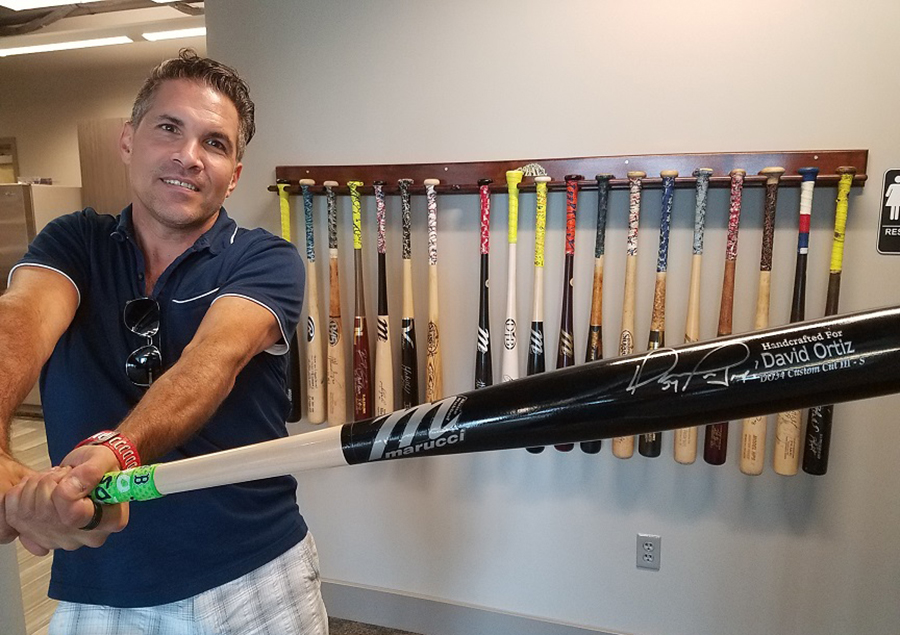Lizard Skins Gripping the Baseball World


Lizard Skins had a long history of gripping handlebars all across the cycling world. But when the company’s general manager, Brad Barker, put a bit of the company’s DuraSoft Polymer grip tape on his baseball bat, he knew that Lizard Skins had a place in gripping far more than just handlebars. They just needed others to believe it, too.
Lizard Skins found that believer after launching its baseball business in 2012 in the form of MLB player John Buck. Leading the majors in home runs and RBIs early in the 2013 season while with the Mets, his use of Lizard Skins grip tape stood out in a world of traditionally gripless wood bats. “It just exploded,” Barker said after people started paying attention to Buck. “That was where the acceptance at the major league level blew up for us and we knew we had an opportunity.”
Soon Lizard Skins was on the bat of Prince Fielder and more and “once we got into the major league level and acceptance happened it continued to snowball.”
Now Lizard Skins serves as the official grip tape of MLB, is used by more than 200 MLB players and has created a new aesthetic style for those gripping wood bats.
With 16 worldwide patents on the product, Lizard Skins uses the same technology for its material compound to create baseball grip as it does for other applications, whether cycling, lacrosse or now hockey. The technology allows them to control the tackiness of the product based on the texturing. With an awareness of the variety of preference and feel that comes with grip, Lizard Skins offers three thicknesses. The standard 1.8 mm thickness adds cushion with the grip, the 1.1 mm version offers versatility and the .5 mm variety, the top choice of the pros, doesn’t add thickness to the handle. Along with differing thickness comes an array of colors. “We created this space,” Barker said. “Bat grip existed before we got into baseball, but we created the category and awareness.”
One thing Lizard Skins didn’t realize would come with the entry into baseball was the use of grip as a fashion accessory. They initially launched with eight different colors, but have expanded well beyond. As style has evolved, camo has turned into the most popular design and MLB players overwhelmingly choose neon. “No team has neon within their color chart,” Barker said. “But it is one of those items that is very popular.”
With grips dialed in, Lizard Skins has since branched out in the baseball world, including into batting gloves. “When we first launched into the batting glove scene, we’d been manufacturing cycling gloves for 15 years,” Barker said. “Making gloves was not new to us.”
To make the baseball product stand out from others, they knew that bulk was the enemy of a glove, so adapted cycling technology into baseball with such things as finger articulation. Fingers have peaks and valleys where joints come together and Lizard Skins designs them in a way to streamline the fit and reduce the bulk. With the wrist strap a key piece of the batting glove, Lizard Skins created a three-piece strap for more comfort and flexibility around the wrist. “One of the habits that happens quite often in baseball is players adjusting the strap on their gloves,” Barker said. “It is one of the key features for a comfortable fit and durability.”
Lizard Skins just finished work on a new knit glove that eliminates seams on the back of the hand to decrease restriction. To ensure durability, Lizard Skins uses only leather on the palms, from goat skin to sheep skin to premium Pittard leather. “We pay attention to all the little details,” Barker said.
New to the Lizard Skins lineup, the Utah-based company has introduced bags and packs and will have arm sleeves later this year. A Grip Boost batting gel solution, designed to take the place of pine tar, adds tackiness to gloves 15 seconds following application.
Coming in November, Lizard Skins will launch 30 MLB team-specific grip designs and a trio of signature grip designs from Anthony Rizzo, Mookie Betts and Eric Hosmer.
“They have all been involved in the design process from colors to features,” Barker said. “Having them involved in all the little details to the end has been a lot of fun.”
All three have already started using their signature grips in games, just another example of the grip Lizard Skins has on baseball.
— Tim Newcomb covers gear and business for Baseball America. Follow him on Twitter at @tdnewcomb.


Comments are closed.